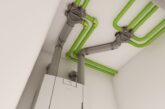
This month, Bradley Hirst, Technical Services Manager from Knauf Insulation, advises on best practice for insulating cavity walls.
Start with certification
You must use insulation that has third party certification verifying its suitability for cavity wall applications, such as Knauf Insulation’s DriTherm Cavity Slab, which has been certified by the BBA. This demonstrates that it meets the performance standards set out in the Building Regulations. For England and Wales, these are Approved Document L (thermal performance) and Approved Document C (moisture).
![]()
Use Mineral Wool insulation
There are two options for insulating cavity walls: full fill, which completely fills the cavity, and partial fill, which leaves an air gap between the insulation and the external leaf.
Mineral Wool, which can be used for both full and partial fill solutions, offers significant benefits over other insulants. It provides the best combined thermal, fire safety and acoustic performance, and it is easier to install correctly. As such, it adapts to any slight imperfections in the substrate and knits together, eliminating air gaps that reduce performance.
By contrast, rigid board insulation often used for partial fill solutions can be more difficult to install correctly. Joints must be taped to eradicate gaps and separate fire barriers are needed, both of which increase costs and installation time.
Match insulation to the cavity depth
For full fill applications, use a Mineral Wool slab of equal width to the cavity to ensure there is intimate contact between the insulation and the masonry leaves.
Using a slab that is too thick will mean the insulation is compressed, compromising its thermal performance. Freshly laid masonry units can also be dislodged when mortar is wet as the insulation will try to recover to its manufactured thickness. Using a slab that is too thin means the required thermal performance won’t be achieved because the cavity isn’t fully filled. Either way, the installation won’t meet the standards determined by the Building Regulations or the testing requirements of the third-party certification.
Keep insulation covered
While Mineral Wool insulation for cavity wall applications does contain a water repellent additive, always cover the top of the cavity at the end of the day or during heavy downpours. This will protect the insulation and masonry from rain and frost during construction in accordance with the requirements of BS 8000-3:2020 workmanship on construction sites, masonry code of practice.
For further information on Knauf Insulation visit https://www.knaufinsulation.co.uk/







